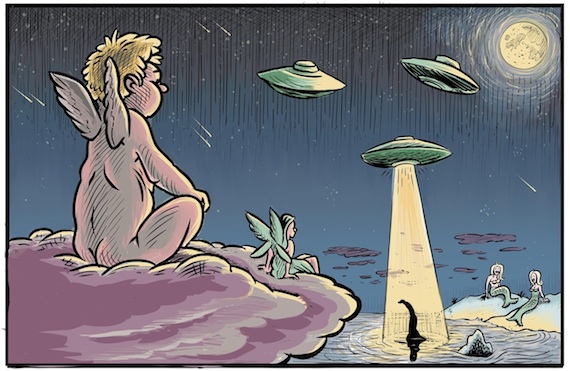
Humans have at least one really redeeming quality. We are loath to abandon a good story. In light of cold, hard facts, our imagination, an engine fired by hope and curiosity, suspicion and fear, will and wish and programmed for storytelling, pushes back. For the last week of December, on Twitter, the Central Intelligence Agency rounded up #Bestof2014 — its ten most-read blog posts and declassified documents from the past year. Number one was a somewhat gently redacted 272-page PDF about an overhead reconnaissance program tested outside of Las Vegas, at a site the agency acknowledges by name as Area 51. “Reports of unusual activity in the skies in the ’50s?” the CIA tweeted. “It was us.” Lockheed spy planes flying at the then unheard altitudes of 60,000 feet and above, sure, but not extraterrestrials casing the planet in saucers. By simply cross-referencing UFO sightings with flight logs, the agency said it was able to rule out more than half of the reports. The reaction? To the bureaucratic dispelling of Area 51, one of the great American wonderlands?
“@CIA Nope, I am still going with aliens from outer-space.”
“@CIA Sorry, but this is STUPID! The USAF began investigations in the late 40s, and #UFOs were seen in abundance all over the US.”
“@CIA with all those redactions 64 years later… who could deny Aliens.”
Squinting into the night, thinking we are not alone…even believing we have routinely been visited upon by a greater intelligence, is one thing. But then there are the creatures presumed indigenous to Earth. From diehard mythos (vampires) to diversions in cryptozoology (the Skunk Ape). In November, BBC published news of an 18-month period in Scotland, which, for the first time since 1925, had failed to produce any confirmed sightings of the lake monster initially reported 1,500 years ago by the Irish abbot and missionary Saint Columba. (By the father’s account, Nessie roared and tore a man “with a most savage bite,” but was driven away by the sign of the cross.) “It’s very upsetting news,” an accountant who apparently moonlights as the registrar of sightings said of Nessie’s recent disappearance, “and we don’t know where she’s gone.” Fresh witnesses came forth shortly thereafter, but then so did a local forest conservation group, which had the bad taste to offer a reasonable explanation: the rivers were washing woodland deadfall into Lake Loch Ness, logs and branches, they suggested, which could look an awful lot like a brontosaurus-style neck on the water’s foggy stage. For believers this was, as one commentator put it, “profoundly unsatisfying.” (A more satisfying explanation, which the BBC noted, is the fact that circus elephants were sometimes exercised in that lake.)
 These episodes recall what happened in 2012, when Animal Planet broadcast Mermaids: The Body Found. The faux documentary blended some real science — such as the aquatic ape hypothesis — and legitimate mysteries — such as an unexplained sound recorded during Navy sonar tests — with the sexiest writing and editing television has to offer. It was a narrative feat of speculative biology that claimed merfolk actually exist, and here the proof. “As if we didn’t have enough probably fictitious but possibly real beings to worry about,” The New York Times pooh-poohed. But Mermaids became the station’s most-watched telecast since the Steve Irwin memorial special aired in September 2006. Indeed, it scored the highest ratings of any Animal Planet program, ever, and with so much of the public convinced, the National Oceanic and Atmospheric Administration felt compelled to issue a statement. The official federal position was (is): “No evidence of aquatic humanoids has ever been found.” Tumblr, a mood board, erupted — “95% of the ocean is undiscovered. You can’t tell me mermaids don’t exist yet.”
These episodes recall what happened in 2012, when Animal Planet broadcast Mermaids: The Body Found. The faux documentary blended some real science — such as the aquatic ape hypothesis — and legitimate mysteries — such as an unexplained sound recorded during Navy sonar tests — with the sexiest writing and editing television has to offer. It was a narrative feat of speculative biology that claimed merfolk actually exist, and here the proof. “As if we didn’t have enough probably fictitious but possibly real beings to worry about,” The New York Times pooh-poohed. But Mermaids became the station’s most-watched telecast since the Steve Irwin memorial special aired in September 2006. Indeed, it scored the highest ratings of any Animal Planet program, ever, and with so much of the public convinced, the National Oceanic and Atmospheric Administration felt compelled to issue a statement. The official federal position was (is): “No evidence of aquatic humanoids has ever been found.” Tumblr, a mood board, erupted — “95% of the ocean is undiscovered. You can’t tell me mermaids don’t exist yet.”
There are, of course, deep, necessary reasons for all of the above. Mythology, as Karen Russell often observes, speaks to perennial aspects of human nature. Half-human creatures are vehicles for reconciling our species on the continuum of other beasts. Monsters are projections of an atavistic unease — born of the sense that something bigger and badder is out to get us (because for the long course of mammalian history, something was). These stories get weird and totally out-of-hand, but they never end.
 I’m thinking of the hilarious Victorian novel Cranford. I was just about finishing it, and noticing the CIA’s roundup in the periphery, when the modern new year rang in. Here was a corner of civilization awash, clinging to habits and opinions morbidly out of date. In the last chapter, Peter Jenkyns returns to entertain the village women with tales from afar. He tells them about the time he was up in the heights of Himalaya, hunting, when he accidentally felled an angel. The Honorable Mrs. Jamieson does not call bullshit. “But, Mr. Peter,” she howls, “shooting a cherubim — don’t you think — I am afraid that was sacrilege!”
I’m thinking of the hilarious Victorian novel Cranford. I was just about finishing it, and noticing the CIA’s roundup in the periphery, when the modern new year rang in. Here was a corner of civilization awash, clinging to habits and opinions morbidly out of date. In the last chapter, Peter Jenkyns returns to entertain the village women with tales from afar. He tells them about the time he was up in the heights of Himalaya, hunting, when he accidentally felled an angel. The Honorable Mrs. Jamieson does not call bullshit. “But, Mr. Peter,” she howls, “shooting a cherubim — don’t you think — I am afraid that was sacrilege!”
Art by Ellis Rosen, illustrator of Woundabout by Lev Rosen, forthcoming from Little, Brown.










